Related Research Articles
General Dynamics Electric Boat (GDEB) is a subsidiary of General Dynamics Corporation. It has been the primary builder of submarines for the United States Navy for more than 100 years. The company's main facilities are a shipyard in Groton, Connecticut, a hull-fabrication and outfitting facility in Quonset Point, Rhode Island, and a design and engineering facility in New London, Connecticut.

USS Holland (SS-1) was the United States Navy's first modern commissioned submarine, although not the first military submarine of the United States, which was the 1775 submersible Turtle. The boat was originally laid down as Holland VI at the Crescent Shipyard of Elizabeth, New Jersey for John Philip Holland's Holland Torpedo Boat Company, and launched on 17 May 1897. She was acquired by the USN on 11 April 1900 and commissioned on 12 October 1900, Lieutenant H. H. Caldwell commanding.

The Royal Netherlands Navy is the naval force of the Kingdom of the Netherlands.

HMS A1 was the Royal Navy's first British-designed submarine, and their first to suffer fatal casualties.

Holland 1 is the first submarine commissioned by the Royal Navy. The first in a six-boat batch of the Holland-class submarine, she was lost in 1913 while under tow to be scrapped following her decommissioning. Recovered in 1982, she was put on display at the Royal Navy Submarine Museum, Gosport. Her battery bank found in the boat was discovered to be functional after being cleaned and recharged.

The Holland 602 type submarine, also known as the H-class submarine, was one of the most numerous submarines of World War I. The type was designed by the Electric Boat Co. of the United States, but most of the boats were built abroad: in Canada by the subsidiary of the British Vickers company and in British shipyards.
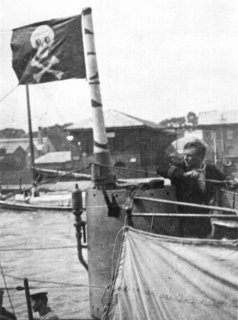
HMS H5 was a British H-class submarine of the Royal Navy that served in the First World War. The boat, which was launched in June 1915, was lost after being rammed by a British merchant ship off Caernarfon Bay in March 1916. It had been mistaken as a German U-boat and sank with the loss of all hands.
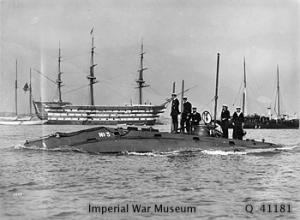
Holland 5 was the last of the five Holland-class submarines ordered by the British Admiralty to evaluate the potential of the submarine with the Royal Navy. She was one of the first submarines to be accepted into Royal Navy service, and unique to her class, she carried one of the earliest periscopes. By the time she was launched, a number of A-class submarines had already been ordered to replace this class in navy service.
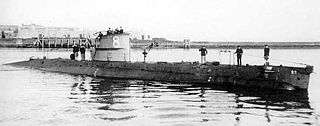
HMS H6 was a British H-class submarine of the Royal Navy built by Canadian Vickers & Co. during World War I.
The Russian submarine AG-12 was an AG-class submarine, designed by the American Holland Torpedo Boat Company/Electric Boat Company, built for the Imperial Russian Navy during World War I. The submarine was fabricated in Canada, shipped to Russia and reassembled for service with the Baltic Fleet. She was scuttled by the Russians at Hanko in April 1918.

The AG-16 was an AG-class submarine, designed by the American Holland Torpedo Boat Company/Electric Boat Company, built for the Imperial Russian Navy during World War I. The submarine was fabricated in Canada, shipped to Russia and reassembled for service with the Baltic Fleet. The boat was originally named AG-13, but was redesignated AG-16 after AG-15 sank and later repaired in 1917. She was scuttled by the Russians at Hanko in April 1918.

The U-5 class was a class of three submarines or U-boats that were operated by the Austro-Hungarian Navy before and during World War I. The class was a part of the Austro-Hungarian Navy's efforts to competitively evaluate three foreign submarine designs.
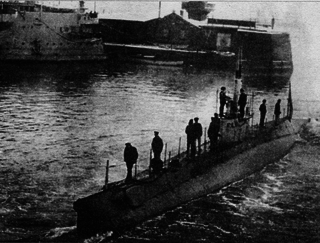
The Russian submarine AG-11 was an AG-class submarine, designed by the American Holland Torpedo Boat Company/Electric Boat Company, built for the Imperial Russian Navy during World War I. The submarine was fabricated in Canada, shipped to Russia and reassembled for service with the Baltic Fleet.

Kommuna is a submarine salvage ship in service with the Russian Navy's Black Sea Fleet and the world's oldest active duty naval vessel. A double-hulled catamaran, she was laid down at the Putilov Factory in St. Petersburg in November 1912 as Volkhov. The ship was launched the following year, and commissioned on 14 July 1915. She was renamed Kommuna on 31 December 1922. Kommuna has served in the Russian Imperial, Soviet, and Russian Federation navies through the Russian Revolution and two World Wars.

The Russian submarine AG-22 was an AG-class submarine, designed by the American Holland Torpedo Boat Company/Electric Boat Company, built for the Imperial Russian Navy during World War I. The submarine was fabricated in Canada, shipped to Russia and reassembled for service with the Black Sea Fleet. Her reassembly was completed in 1919 by the White Movement during the Russian Civil War, and she joined Wrangel's fleet as it evacuated the Crimea in 1920 and was interned in Bizerte, Tunisia in 1921. AG-22 was abandoned there and subsequently scrapped.
O 11 was a O 9-class patrol submarines of the Royal Netherlands Navy. The ship was built by Fijenoord shipyard in Rotterdam.

K XIII was a K XI class patrol submarines of the Royal Netherlands Navy. The ship was built by Fijenoord shipyard in Rotterdam.
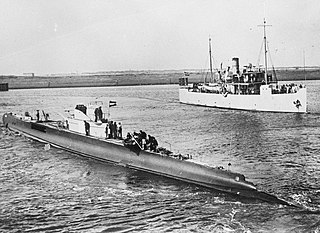
K XVII was one of five K XIV-class submarines built for the Royal Netherlands Navy. She served during World War II.

K XVIII was one of five K XIV class submarines built for the Royal Netherlands Navy. She served during World War II.

HNLMS Mercuur (A900) is a submarine support ship of the Royal Netherlands Navy. The ship was built and designed specially to support the Dutch submarines. She entered service on 21 August 1987, and is the only surface vessel attached to the Dutch submarine service.
References
- Hutchinson, Robert (2001). Jane's submarines : war beneath the waves from 1776 to the present day. London: HarperCollins. ISBN 978-0007105588..